- Analytics
- News and Tools
- Quotes
- Chart and quotes for GBPUSD
CFD Trading Rate Great Britain Pound vs US Dollar (GBPUSD)
| Date | Rate | Change |
|---|
Related news
-
14.03.2024 00:05GBP/USD holds above the 1.2800 mark ahead of US Retail Sales data
- GBP/USD holds positive ground around 1.2805 in Thursday’s early Asian session.
- The UK GDP growth numbers rose 0.2% MoM in January vs. -0.1% prior.
- Investors have priced in 71 basis points (bps) in rate cuts this year from 95% at the beginning of the week.
The GBP/USD pair hovers around the 1.2800 mark during the early Asian trading hours on Thursday. The modest uptick of the major pair is supported by the weaker US Dollar (USD). Nonetheless, a cautious mode in the market ahead of the key US event might boost the Greenback and cap the upside of the pair. GBP/USD currently trades near 1.2604, adding 0.05% on the day.
On Wednesday, the UK monthly GDP estimate rose 0.2% MoM in January from a 0.1% contraction in the previous reading, according to the Office for National Statistics (ONS). However, the improved data failed to lift the Pound Sterling as investors believe the UK economy is likely to end the 2023 H2 recession. Meanwhile, Industrial Production dropped 0.2% in January from December’s reading of 0.6% MoM gain.
Across the pond, traders, we will closely monitor the US Retail Sales data for February, which might influence the Fed’s next move. The figure is estimated to show a rise of 0.8% MoM from a 0.8% fall in January. The stronger-than-expected report might convince the Fed to shift to a less-dovish setting. According to the CME FedWatch Tools, Fed funds futures now see 71 basis points (bps) in rate cuts this year from 95% at the beginning of the week.
Looking ahead, the US February Retail Sales data will be the highlight on Thursday. This event might trigger volatility in the market. On Friday, the UK Consumer Inflation Expectations will be released. Next week, investors will shift their attention to the FOMC interest rate decision. -
13.03.2024 20:05GBP/USD trades thin on Wednesday as markets wait for a push
- Pound Sterling stubbornly stuck to Wednesday’s opening range.
- A smattering of UK data sparked some volatility, but little movement.
- US Retail Sales and PPE figures in the barrel for Wednesday.
GBP/USD found some volatility on Wednesday, but overall directional momentum remains limited with the pair rangebound and pinned close to the day’s opening range near 1.2790. Technicals are struggling to push into either side of the 1.2800 handle in the midweek trading session, and investors are awaiting a spark in the data.
UK Industrial Production fell to -0.2% in January after December’s 0.6% print, missing the forecast flat print of 0.0%. UK MoM Manufacturing Production also declined, coming in at the expected 0.0% compared to the previous 0.8%. UK Gross Domestic Product (GDP) in January also met expectations, printing at 0.2% versus the previous -0.1%.
A thin showing for US data on Wednesday leaves investors waiting for Thursday’s Retail Sales and Producer Price Index (PPI) numbers. US Retail Sales are expected to rebound in February, with the median market forecast calling for a 0.8% print after January’s -0.8% decline. Meanwhile, February’s Core YoY PPI through February is expected to ease slightly, forecast to print at 1.9% compared to the previous 2.0%.
The trading week will wrap up with the University of Michigan’s Consumer Sentiment Index, which is broadly expected to hold steady at 76.9. Before that, mid-tier consumer inflation expectations from the UK will be seen early Friday during the London market session. At least read, UK consumers expected UK inflation to land somewhere around 3.3% for the following 12 months.
GBP/USD technical outlook
GBP/USD is cycling into the midweek, churning into the midrange as the pair grapples with an inflection point priced in just above 1.2750. Hourly candles have dropped a potential break of character just below the 1.2900 handle, and near-term action is set to consolidate until the stronger pattern emerges.
Daily candles are draining back into a heavy supply zone after a six-day bull run promptly ended this week, with the pair failing to capture to 1.2900. Consolidation plagues GBP/USD in the medium-term, and a bullish bounce from the 200-day Simple Moving Average (SMA) at 1.2590 is seeing limited topside momentum.
GBP/USD chart, hourly
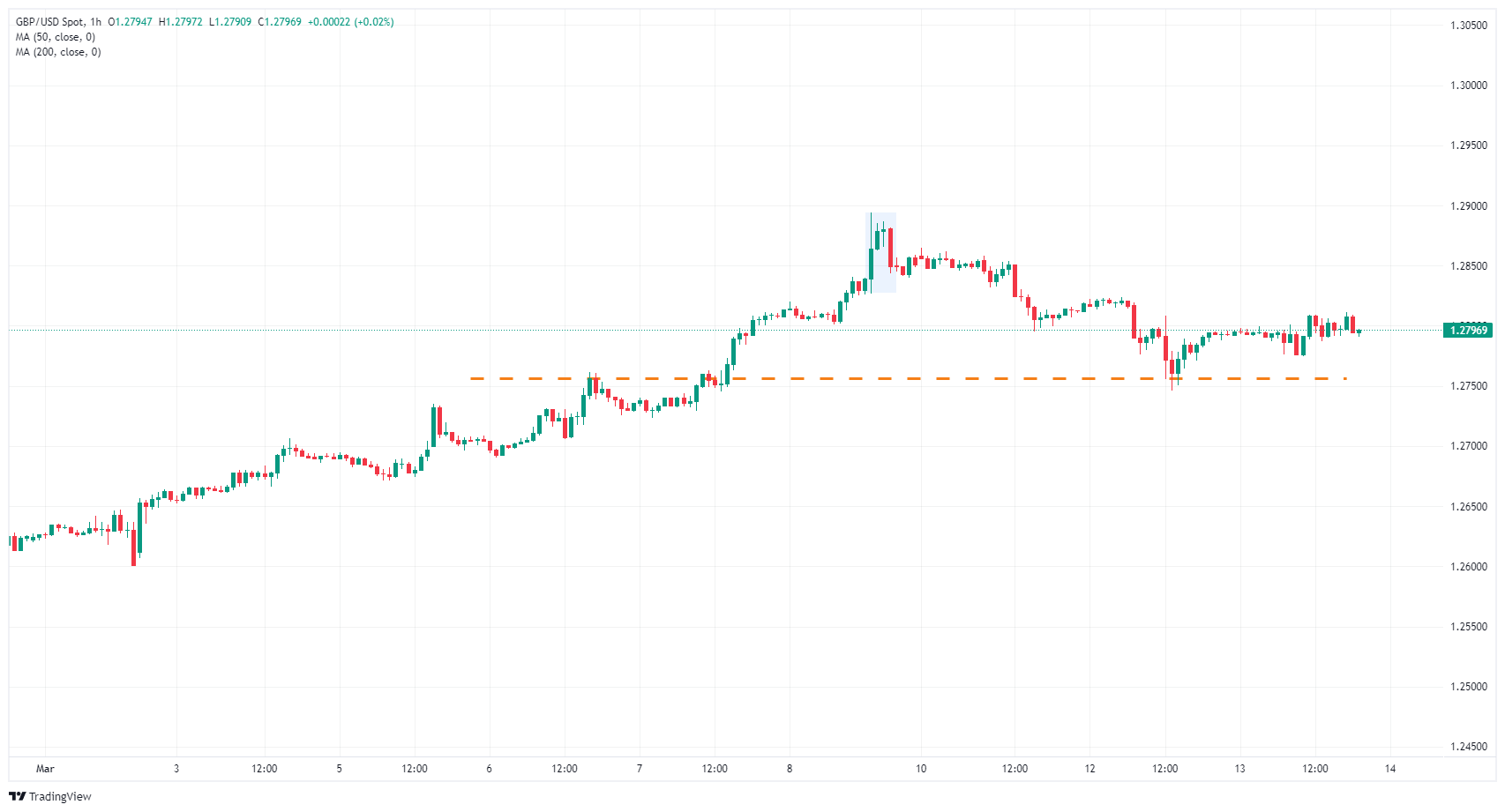
GBP/USD chart, daily
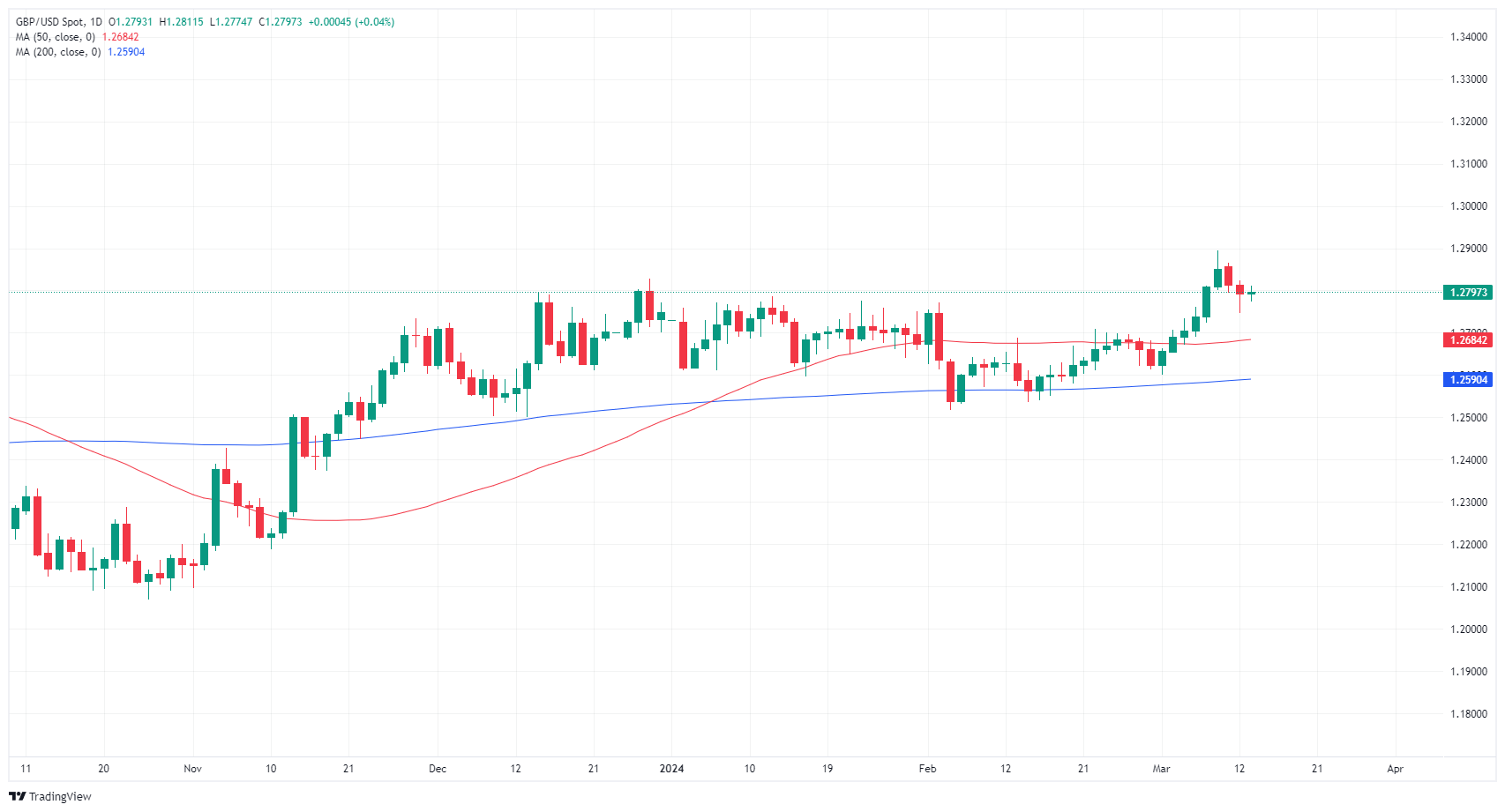
-
13.03.2024 03:52GBP/USD Price Analysis: Consolidates near 1.2800 ahead of UK GDP, bulls have the upper hand
- GBP/USD lacks any follow-through buying and oscillates in a range on Wednesday.
- Delayed BoE rate cut bets underpin the GBP and lend support amid a softer USD.
- Bulls, however, refrain from placing aggressive bets ahead of the UK monthly GDP.
The GBP/USD pair struggles to capitalize on the previous day's late rebound from levels below mid-1.2700s, or the weekly low and oscillates in a narrow trading band during the Asian session on Wednesday. Spot prices currently trade just below the 1.2800 mark, unchanged for the day as traders opt to wait on the sidelines ahead of important macro releases from the UK, including the monthly GDP print.
In the meantime, bets that the Federal Reserve (Fed) will start cutting interest rates in June, despite the warmer US consumer inflation, along with a generally positive risk tone, keep the US Dollar (USD) bulls on the defensive. Adding to this, expectations that the Bank of England (BoE) might keep interest rates higher for longer underpin the British Pound (GBP) and lend some support to the GBP/USD pair.
From a technical perspective, spot prices showed some resilience and bounced from a strong resistance breakpoint around the 1.2750 region on Tuesday. The said area should now act as a key pivotal point, which if broken decisively might prompt some technical selling and drag the GBP/USD pair below the 1.2700 mark, towards testing the 50-day Simple Moving Average (SMA) support near the 1.2680 zone.
A convincing break below the latter might expose the 1.2600 confluence, comprising the 100- and the very important 200-day SMAs. The subsequent downfall has the potential to drag the GBP/USD pair towards the 1.2520-1.2515 region, or the YTD low touched in February.
On the flip side, the 1.2850-1.2855 region is likely to act as an immediate hurdle, above which spot prices could climb back to the 1.2900 neighbourhood, or the highest level in over eight months touched last Friday. Given that oscillators on the daily chart are holding in the positive territory and are still far from being in the overbought zone, some follow-through buying will be seen as a fresh trigger for bullish traders.
The GBP/USD pair might then accelerate the positive momentum towards the next relevant hurdle near the 1.2940-1.2945 region before aiming to reclaim the 1.3000 psychological mark for the first time since July 2023.
GBP/USD daily chart
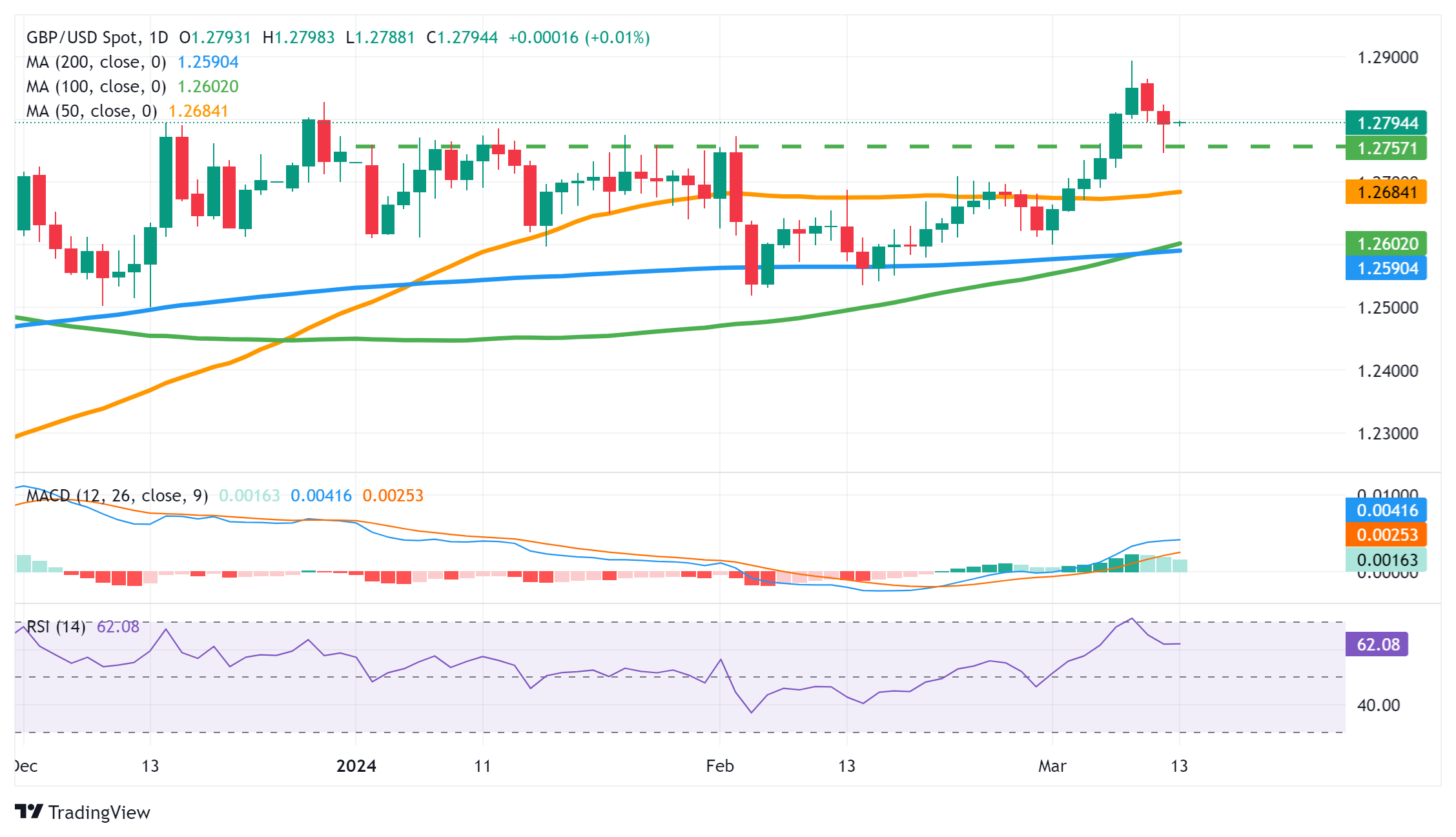
-
13.03.2024 00:08GBP/USD struggles to gain ground above the 1.2800 mark, UK GDP data eyed
- GBP/USD remains capped under the 1.2800 barrier on the stronger USD in Wednesday’s Asian session.
- The US CPI rose 0.4% MoM and 3.2% YoY in February; the Core CPI climbed 0.4% MoM and 3.8% YoY.
- The annual rate of wage growth in the United Kingdom (UK) is falling from November last year to January 2024.
The GBP/USD pair holds below the 1.2800 psychological barrier during the early Asian trading hours on Wednesday. The firmer US Dollar (USD) after the US February CPI inflation data drags the major pair lower. Investor. Investors await the UK GDP growth number for January, which is forecast to grow by 0.2% MoM. GBP/USD currently trades around 1.2795, adding 0.02% on the day.
US inflation, as measured by the Consumer Price Index (CPI), rose 0.4% MoM and 3.2% YoY in February, the Bureau of Labor Statistics revealed on Tuesday. The monthly CPI figure was in line with expectations, while the annual figure was above the market consensus of 3.1%. The Core CPI, excluding volatile food and energy prices, climbed 0.4% MoM and 3.8% YoY, beating the estimation.
The stronger-than-expected CPI inflation data might convince Federal Reserve (Fed) policymakers to wait at least until the summer before starting to lower interest rates. Fed officials emphasized in recent weeks that rate cuts are likely at some point this year, but they caution about reacting too soon in the battle against high prices. Investors will take more cues from the February Retail Sales on Thursday, which is expected to rise 0.8% MoM. The strong Retail Sales data might prompt some further repricing of anticipation following the February CPI inflation report.
Data released from the Office for National Statistics (ONS) reported on Tuesday that the annual rate of wage growth in the United Kingdom (UK) is falling. The UK Average Earnings Including Bonuses from November last year to January 2024 eased to 5.6% from 5.8% in the previous reading, while annual wage growth excluding bonuses dropped to 6.1% versus 6.2% prior. In response to the data, the bets for the Bank of England (BoE) rate cuts this year increased marginally, and traders expect three rate cuts this year.
Moving on, traders will keep an eye on the UK monthly Gross Domestic Product for January, Construction Output, Goods Trade Balance, Industrial Production, and Manufacturing Production, due on Wednesday. On Thursday, US Retail Sales for February will be in the spotlight. -
12.03.2024 12:10GBP/USD: Gains could resume on a rebound back above 1.2815/1.2820 – Scotiabank
GBP/USD’s corrective drift extends after softer wage data. Economists at Scotiabank analyze the pair’s outlook.
The dip in Cable retains a corrective look
Average Weekly Earnings growth eased to 5.6% in the three months through January (down from 5.8% and a bit below consensus estimates for a 5.7% gain). Ex-bonus pay eased to 6.1% over the same period, against expectations of a steady (6.2%) outcome. Jobs data showed some softening in labour markets. Easing pay pressures and a cooling labour market will be welcomed by policymakers.
GBP losses from last week’s high have extended a little further today but the dip in Cable retains a corrective look (bull flag potential), implying that gains could resume on a rebound back above 1.2815/1.2820 intraday.
Support is 1.2755/1.2765.
-
12.03.2024 11:59GBP/USD Price Analysis: Rally stalls after touching 200-week SMA
- GBP/USD has pulled back after touching resistance from the 200-week SMA.
- The pair could be forming an ABC move on the daily chart with a target in the 1.3000s.
- The 4-hour chart is looking a little vulnerable but remains supported for now.
GBP/USD has been rallying higher but it has stalled at the start of the new week after touching resistance at the 200-week Simple Moving Average (SMA). So far, the pullback looks like a correction in an evolving uptrend.

Pound Sterling vs US Dollar: Weekly chart
The pair has probably formed a bullish three-wave ABC Measured Move. If so, we are currently in the middle of the C wave, which should end somewhere between 1.3045 – 61.8% Fibonacci extension of wave A – and 1.3340, which is where C is 100% of A. The July highs in the 1.3130s is another target for the end of C.

Pound Sterling vs US Dollar: Daily chart
A strong, decisive move back above the 1.2890 highs could provide the confirmation of an extension of C to its target.
The 4-hour chart below shows a less bullish short-term technical picture.
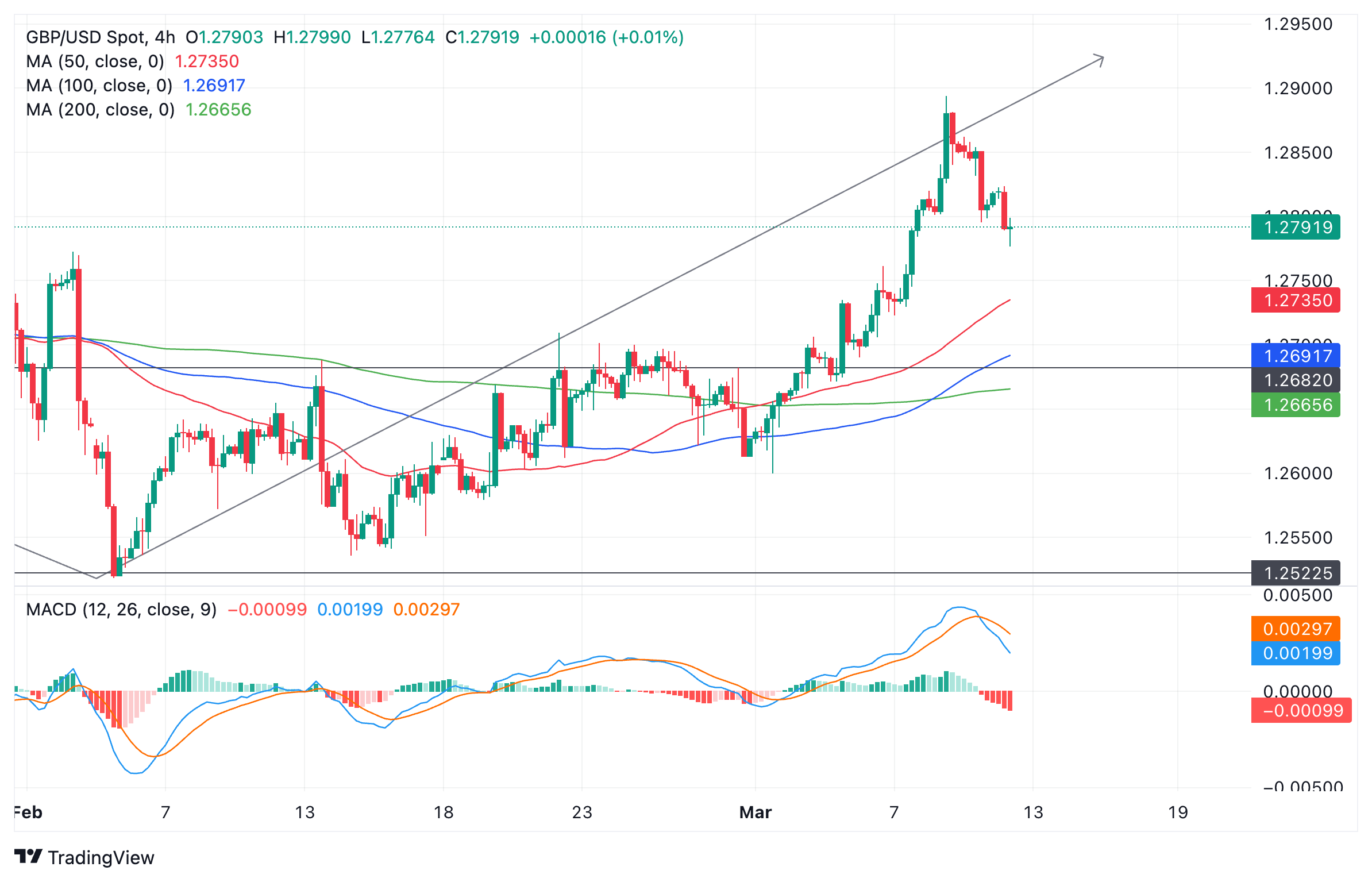
Pound Sterling vs US Dollar: 4-hour chart
GBP/USD has started to slide lower, reversing the rising peaks and troughs. The Moving Average Convergence Divergence (MACD) indicator has also crossed below its signal line offering a bearish sell signal.
The short-term uptrend is, therefore, a little in doubt, however, the fact that momentum on the way down from the March 8 peak has been slower than on the way up continues to favor a pullback rather than reversal thesis.
It is possible this pullback could continue lower to support between 1.2730 (from the 200-4hr SMA) and 1.2680, before turning around.
Traders should watch for a bullish candlestick reversal pattern or peaks and troughs climbing again for a sign the dominant uptrend is resuming. A break above 1.2860, if accompanied by strong momentum, would also suggest bulls are back in the saddle, with targets at the aforementioned ends of Wave C.
A break below 1.2720, however, would suggest the trend on a short-term basis has reversed and the pair was going lower again, probably to a target zone back in the 1.2600s where the pair was rangbound during February.
-
11.03.2024 23:59GBP/USD holds above the 1.2800 mark, eyes on UK labour market, US CPI data
- GBP/USD trades with mild negative bias near 1.2814 in Tuesday’s early Asian session.
- BoE’s Mann said UK has a long way to go for inflation pressures to be consistent with the 2% target.
- The cautious mood ahead of key events might lift the safe-haven flow, and benefit the USD.
- The UK labour market data and US CPI inflation report will be closely watched events on Tuesday.
The GBP/USD pair remains on the defensive above the 1.2800 support during the early Asian trading hours on Tuesday. The lower bets on rate cut expectations from the Bank of England (BoE) weigh on the Pound Sterling (GBP). Investors await the UK labour market data and US CPI inflation data on Tuesday for fresh impetus. GBP/USD currently trades near 1.2814, unchanged for the day.
The BoE policymaker Catherine Mann said on Monday that the UK has a long way to go for inflation pressures to be consistent with the central bank's 2% target. According to UBS Global Research on Monday, the BoE is anticipated to begin lowering interest rates, with a 25 basis point (bps) cut in August, compared to its prior expectation of a cut in May.
On the other hand, a cautious mood in the market ahead of the key events from both the UK and US might provide some support to safe-haven assets like the US Dollar (USD). The US February Consumer Price Index (CPI) figure is estimated to remain steady at 3.1% YoY, and the Core CPI is projected to ease from 3.9% to 3.7% in February. A stronger-than-expected CPI report would further dampen hopes of a rate cut by the Fed over the near term. This, in turn, might boost the Greenback and create a headwind for the GBP/USD pair.
Looking ahead, market players will keep an eye on the UK labor market data, including Employment Change, Claimant Count Change, ILO Unemployment Rate, and Average Earnings. On the US docket, the CPI inflation data for February will be released later on Tuesday. These events could trigger the volatility in the market and give a clear direction to the GBP/USD pair. -
11.03.2024 17:37GBP/USD backslides on Monday, finds near-term floor at 1.2800
- GBP/USD sheds weight after rate cut expectations get pushed out.
- NY Fed noted an uptick in consumer inflation expectations.
- Markets await Tuesday’s US CPI inflation print.
GBP/USD pared away some gains on Monday, falling from 1.2860 back into the 1.2800 price handle as markets trim rate cut expectations from the Bank of England (BoE). According to the Union Bank of Switzerland (UBS), the BoE is expected to deliver a first rate trim in August versus the previously-expected May.
Investors are looking ahead to Tuesday’s UK labor figures, followed by the US Consumer Price Index (CPI) inflation print. Markets continue to chew on hopes for a rate cut from the BoE and the Federal Reserve (Fed).
The UK’s ILO Unemployment rate for the quarter ended January is expected to hold steady at 3.8%, while Average Earnings Including Bonuses for the annualized quarter ended in January are forecast to slip to 5.7% from the previous 5.8%. With Average Wages Excluding Bonuses expected to hold steady at 6.2%, markets expect consumers’ bonuses to decline.
US CPI Preview: Forecasts from 10 major banks, inflation still too high
February’s US MoM CPI print is expected to accelerate to 0.4% from 0.3% as uneven inflation continues to weigh. Core MoM CPI, which excludes food and energy prices, is expected to tick down to 0.3% from 0.4%.
Annualized CPI is forecast to hold at 3.1% with Core YoY CPI expected to come in at 0.3% versus the previous 0.4%.
GBP/USD technical outlook
GBP/USD is set to snap a winning streak, aimed to the downside on Monday after closing in the green for six consecutive trading days. The pair briefly broke out of the top side of a heavy supply zone, but failure to capture the 1.2900 handle on Friday is sending the GBP/USD back below resistance.
Despite near-term bearish momentum, the pair remains well above the 200-day Simple Moving Average (SMA) at 1.2586. The pair has climbed 3% bottom-to-top from the last major swing low into 1.2518.
GBP/USD hourly chart
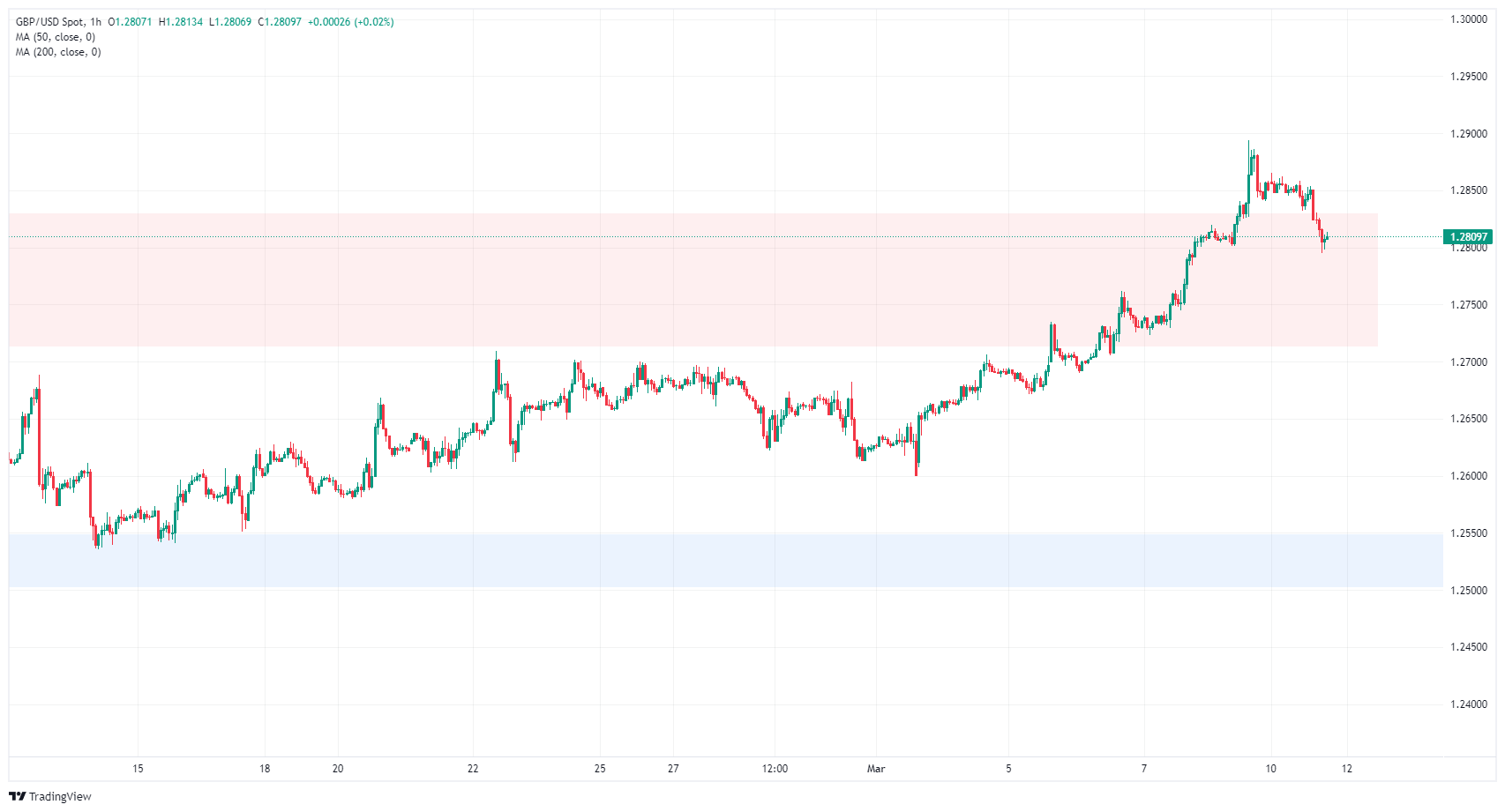
GBP/USD daily chart

-
11.03.2024 12:36GBP/USD to see additional gains to 1.3000+ in the next few weeks – Scotiabank
Cable’s gains are holding comfortably in the mid-1.2800s, the highest for the pound since last July. Economists at Scotiabank analyze GBP/USD outlook.
Cable consolidates solid gains through recent range ceiling
Sterling’s gains through the low 1.2800s last week take Cable out of its long-standing trading range and target additional gains to 1.3000+ in the next few weeks, potentially.
Short-term price action looks more consolidative, however, with spot holding well within Friday’s range.
Support is 1.2790/1.2800. Resistance is 1.2880/1.2890.
See – EUR/GBP: Break below 0.8490 can extend the decline towards next projections at 0.8455/0.8440 – SocGen
-
11.03.2024 02:49GBP/USD remains steady near the 1.2850, awaits UK employment data
- GBP/USD consolidates amid a muted US Dollar on Monday.
- US Nonfarm Payrolls increased by 275K in February, against the expected 200K.
- Traders await employment data to gain fresh impetus on the United Kingdom’s labor market.
GBP/USD hovers around 1.2850 during the Asian session on Monday, maintaining a positive sentiment to potentially extend its winning streak that commenced on March 1. However, the US Dollar (USD) has received upward strength and recovered from intraday losses on Friday following the release of upbeat US Nonfarm Payrolls data.
In February, US Nonfarm Payrolls increased by 275K, surpassing January's figure of 229K and beating expectations of 200K. However, US Average Hourly Earnings (YoY) grew by 4.3%, slightly below both the estimated and previous reading of 4.4%. Monthly, there was an increase of 0.1%, which was lower than the anticipated 0.3% and the previous month's 0.5%.
The GBP/USD pair continues to maintain a positive tone as markets widely anticipate the Federal Reserve (Fed) to cut interest rates before the Bank of England (BoE), potentially narrowing the policy divergence between the two central banks for a period. Federal Reserve (Fed) Chair Jerome Powell, during his testimony before the US Congress last week, reiterated the central bank's stance. Powell hinted at potential cuts in borrowing costs sometime this year, emphasizing that such actions would be contingent upon the inflation trajectory aligning with the Fed's target of 2%.
Last week, UK Chancellor of the Exchequer Jeremy Hunt delivered the Spring Budget to Parliament. This boosted positive sentiment surrounding the United Kingdom’s (UK) budget, particularly as the Office for Budget Responsibility (OBR) forecasted stronger economic growth.
Market participants eagerly anticipate employment data from the United Kingdom (UK), including the ILO Unemployment Rate (3M) and Employment Change figures, scheduled for release on Tuesday. Additionally, the Consumer Price Index data for February is also on the radar for investors and analysts alike.
-
08.03.2024 05:04GBP/USD Price Analysis: Appreciates to near 1.2810 followed by December’s high
- GBP/USD targets December high at 1.2828 and August high at 1.2841.
- Technical analysis suggests a confirmation of the bullish trend for the pair.
- The psychological level of 1.2800 appears as an immediate support level.
GBP/USD seems to continue its winning streak that began on March 1, hovering around 1.2810 during the Asian session on Friday. The GBP/USD pair receives upward support as the US Dollar (USD) faces challenges on improved risk appetite amid lower US Treasury yields.
The GBP/USD pair finds the immediate barriers at December’s high at 1.2828 and August’s high at 1.2841. A break above these levels could support the pair to test the major level of 1.2850, followed by the psychological resistance area around the 1.2900 level.
The technical analysis of the GBP/USD pair shows that the 14-day Relative Strength Index (RSI) is positioned above 50. This indicates a bullish momentum for the pair. Additionally, the Moving Average Convergence Divergence (MACD), a lagging indicator, suggests a confirmation of the bullish trend for the pair. This is evident from the MACD line being situated above the centerline and shows the divergence above the signal line.
The GBP/USD pair may encounter immediate support at the psychological level of 1.2800 following further support near the major level at 1.2750. A break below the major level could push the pair to test the nine-day Exponential Moving Average (EMA) at 1.2726.
Further support lies at the psychological level of 1.2700, a surpassing of this level could lead the GBP/USD pair to test the 23.6% Fibonacci retracement level of 1.2641.
GBP/USD: Daily Chart
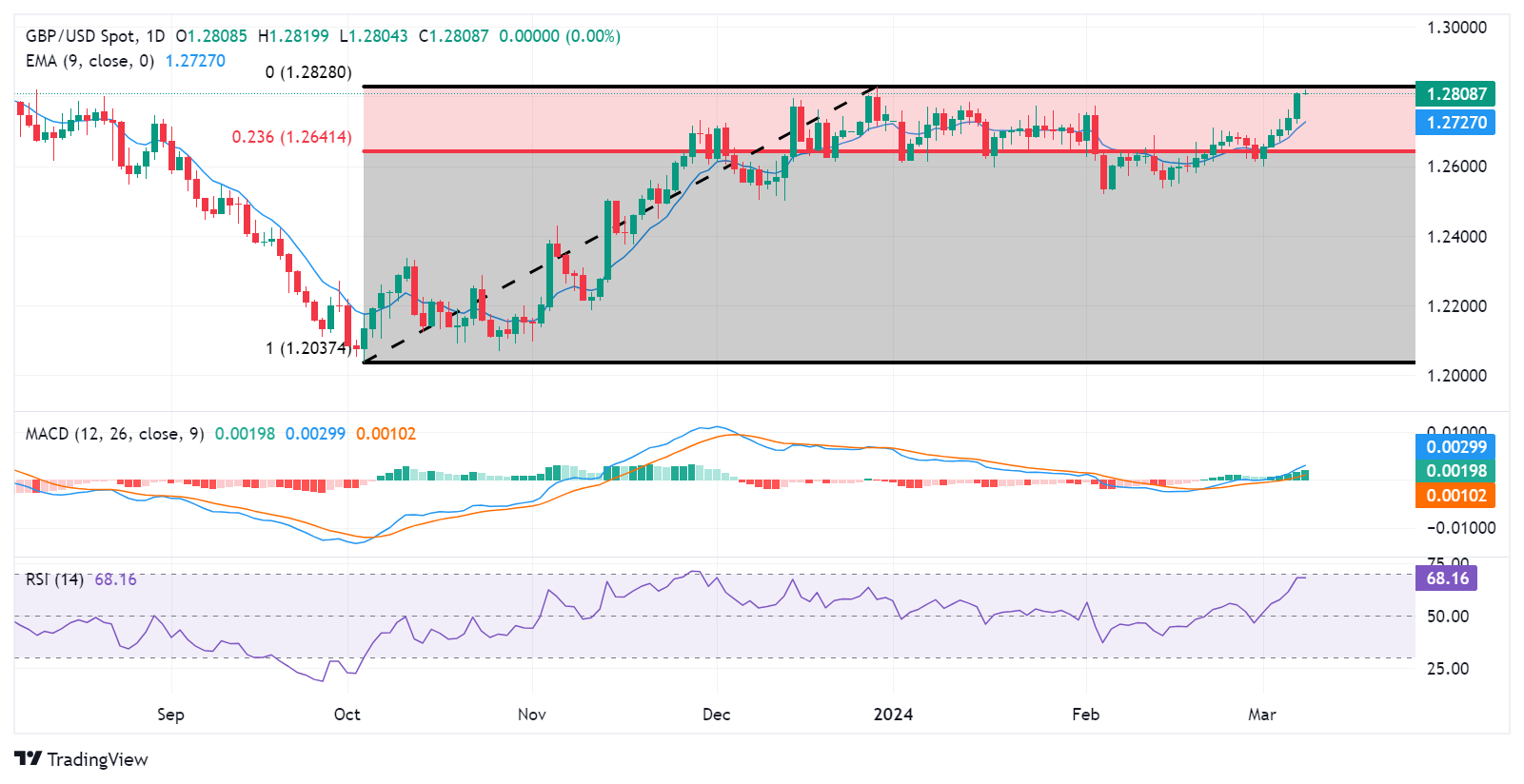
-
07.03.2024 23:46GBP/USD clinches fresh 2024 highs above 1.2800 ahead of US NFP data
- GBP/USD attracts some buyers to a fresh 2024 high above 1.2800 on the weaker USD.
- Fed Chair Powell said interest rate cuts may not be too far off if inflation signals cooperate.
- Investors expect the BoE to lower interest rates after the Fed, which boost the Pound Sterling.
- The US February labor market report will be a closely watched event.
The GBP/USD pair holds ground above the 1.2800 psychological barrier during the early Asian trading hours on Friday. The selling pressure in the US Dollar (USD) provides some support to the major pair. The highlight on Friday will be the US labor market data for February. GBP/USD currently trades around 1.2810, up 0.01% on the day.
The Federal Reserve (Fed) Chairman Jerome Powell presents the Monetary Policy Report and responds to questions before the Senate Banking Committee on Thursday. Powell said that interest rate cuts may not be too far off if inflation signals cooperate. Fed Chair didn’t provide a precise timetable for rate cuts but noted that the day could be coming soon. Investors expect the first cut to come in June, with four reductions totaling a full percentage point by the end of 2024.
On the other hand, the financial markets anticipate that the Bank of England (BoE) to lower interest rates after the Fed. This, in turn, boosts the Pound Sterling (GBP) and acts as a tailwind for the GBP/USD pair. Investors expect the BoE to start easing in the August meeting. Nonetheless, BoE policymakers will see more evidence of inflation before making a decision.
Moving on, traders will keep an eye on the US February Nonfarm-Payrolls, Unemployment Rate, and Average Hourly Earning, due on Friday. These events could trigger volatility in the market. Market players will take cues from the data and find trading opportunities around the GBP/USD pair.
-
07.03.2024 15:13GBP/USD surges against US Dollar on soft US jobs data, eyes on Powell
- Sterling climbs, benefiting from a weaker dollar after disappointing US employment figures.
- Initial Jobless Claims rise to 217K, underscoring cooling US labor market despite Powell's openness to future policy easing.
- UK's economic growth forecasts bolster GBP, with Chancellor Hunt presenting optimistic projections for 2024 and 2025.
The Pound Sterling moderately advanced in the North American session on Thursday, as the Greenback remains on the defensive after a soft jobs report from the United States (US). Therefore, the GBP/USD trades at 1.2756, up 0.19%.
GBP/USD edges up on weak US economic data
US economic data is not helping the US Dollar, which is failing to gain traction following Federal Reserve Chair Jerome Powell's speech on Wednesday. Powell didn’t say anything dovish other than acknowledging that the Federal Reserve would ease policy “at some point this year,” though he emphasized that it would depend on data. He would speak again on Thursday at around 15:00 GMT.
In the meantime, the labor market is cooling. The Initial Jobless Claims for the week ending March 2 came at 217K, surpassing estimates and the previous reading of 215 K. Today’s data confirms Wednesday’s US Job Openings and Labor Turnover Survey (JOLTS), which revealed that there were 8.863 M job openings, which fell short of estimates and was lower than December’s 8.889M.
Other data showed that private hiring improved by 140K, less than forecasts of 150K. On Friday, the US Department of Labor will release the Nonfarm Payrolls for February, which are expected to rise by 200K, less than January’s 353K.
Across the pond, the UK’s Chancellor of the Exchequer, Jeremy Hunt, presented the spring budget to the House of Commons. Hunt stated the UK economy is estimated to grow by 0.8% in 2024 and 1.9% in 2025, stronger than the 0.7% and 1.4% growth rates forecast by the Office for Budget Responsibility (OBR) in November.
GBP/USD Price Analysis: Technical outlook
The GBP/USD resumed its uptrend following Powell’s speech and US economic data, with buyers targeting the 1.2800 figure. It should be said that Relative Strength Index (RSI) studies are bullish and not in overbought territory, an indication that the rally has legs. Above 1.2800, the next resistance would be the psychological 1.2850, followed by the 1.2900 mark. On the other hand, if sellers drag the exchange rate below the March 6 high of 1.2761, that could open the door for a correction. The next support would be today’s low at 1.2722, followed by the 1.2700 figure.
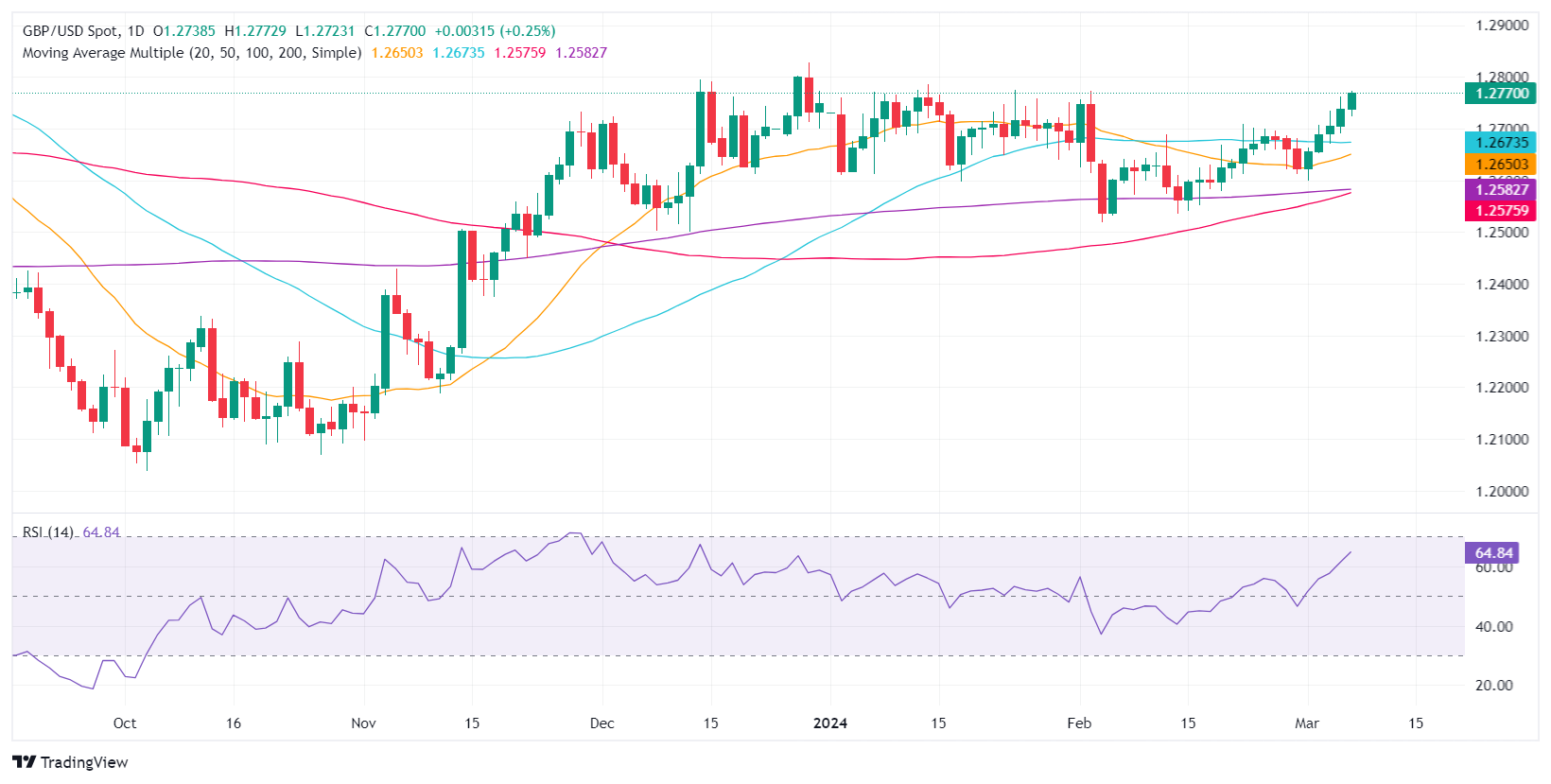
Pound Sterling FAQs
The Pound Sterling (GBP) is the oldest currency in the world (886 AD) and the official currency of the United Kingdom. It is the fourth most traded unit for foreign exchange (FX) in the world, accounting for 12% of all transactions, averaging $630 billion a day, according to 2022 data. Its key trading pairs are GBP/USD, aka ‘Cable’, which accounts for 11% of FX, GBP/JPY, or the ‘Dragon’ as it is known by traders (3%), and EUR/GBP (2%). The Pound Sterling is issued by the Bank of England (BoE).
The single most important factor influencing the value of the Pound Sterling is monetary policy decided by the Bank of England. The BoE bases its decisions on whether it has achieved its primary goal of “price stability” – a steady inflation rate of around 2%. Its primary tool for achieving this is the adjustment of interest rates. When inflation is too high, the BoE will try to rein it in by raising interest rates, making it more expensive for people and businesses to access credit. This is generally positive for GBP, as higher interest rates make the UK a more attractive place for global investors to park their money. When inflation falls too low it is a sign economic growth is slowing. In this scenario, the BoE will consider lowering interest rates to cheapen credit so businesses will borrow more to invest in growth-generating projects.
Data releases gauge the health of the economy and can impact the value of the Pound Sterling. Indicators such as GDP, Manufacturing and Services PMIs, and employment can all influence the direction of the GBP. A strong economy is good for Sterling. Not only does it attract more foreign investment but it may encourage the BoE to put up interest rates, which will directly strengthen GBP. Otherwise, if economic data is weak, the Pound Sterling is likely to fall.
Another significant data release for the Pound Sterling is the Trade Balance. This indicator measures the difference between what a country earns from its exports and what it spends on imports over a given period. If a country produces highly sought-after exports, its currency will benefit purely from the extra demand created from foreign buyers seeking to purchase these goods. Therefore, a positive net Trade Balance strengthens a currency and vice versa for a negative balance.
-
07.03.2024 00:19GBP/USD trades on a stronger note below 1.2750 on a weaker US Dollar, UK’s budget
- GBP/USD trades in positive territory for the fifth consecutive day near 1.2735 on Thursday.
- Fed's Chair Powell said rate cuts are likely at some point this year.
- UK Chancellor Jeremy Hunt said the UK economy is estimated to grow by 0.8% in 2024 and 1.9% in 2025.
- The US weekly Initial Jobless Claims and Trade Balance will be released on Thursday.
The GBP/USD pair breaks above the 1.2700 barrier and currently trades around 1.2735 during the early Asian session on Thursday. The uptick of the major pair is bolstered by the weaker US Dollar (USD) and encouraging news from the UK Spring Budget.
The Federal Reserve (Fed) Chair Jerome Powell told House lawmakers on Wednesday that interest rates might start coming down this year, but also cautioned that the Fed would take its time until the central bank gains greater confidence that inflation is moving sustainably toward the 2% target. Powell’s comment indicated that the Fed officials remain cautious about not losing the progress made against inflation, and the decision-making will be based on incoming data.
About the data, the US JOLTS job openings fell to 8.863M in January from the previous reading of 9.026M, below the market consensus of 8.900M. The ADP private sector employment climbed 140,000 in February from 111,000 in January, weaker than the market expectation of 150,000.
The UK’s Chancellor of the Exchequer, Jeremy Hunt, presented the spring budget to the House of Commons. Hunt said that the UK economy has dealt with the financial crisis, the pandemic, and the energy crisis caused by the war in Europe, while also adding that interest rates will remain high as the central bank tries to bring down inflation.
Additionally, Hunt said the UK economy is estimated to grow by 0.8% in 2024 and 1.9% in 2025, stronger than the 0.7% and 1.4% growth rates forecast by the Office for Budget Responsibility in November. That being said, the encouraging comments and the high-for-longer rate narrative in the UK lift the Pound Sterling (GBP) and act as a tailwind for the GBP/USD pair.
The US weekly Initial Jobless Claims and Trade Balance are due on Thursday. Investors will also take more cues from the second testimony by Chair Powell and Fed’s Mester speech later in the day. On Friday, attention will shift to US Nonfarm Payrolls, which is projected to see 200K job additions in February from the previous reading of 353K. -
06.03.2024 19:48GBP/USD eyes 1.2800 as UK’s budget and Powell’s comments lift the Pound
- GBP/USD rallies, buoyed by UK's positive spring budget outlook and Powell's testimony on US economic strength.
- UK Chancellor Hunt's budget reveals tax cuts and economic growth projections, boosting confidence in sterling's trajectory.
- Despite mixed US job data, Powell's reassurances on inflation and economic growth support GBP/USD's upward movement.
The GBP/USD climbed 0.31% during the North American session and traded at 1.2746 after bouncing off daily lows of 1.2690. UK’s spring budget announcement and US Federal Reserve’s Chair Jerome Powell's testimony sponsored a leg-up in the pair, which is set to test the 1.2800 mark.
Serling post gains in optimistic UK’s budget
The UK’s Chancellor of the Exchequer, Jeremy Hunt, presented the spring budget to the House of Commons. Hunt said that according to the Office for Budget Responsibility (OBR), the economy is expected to grow 0.8% in 2024 and 1.9% next year, 0.5% higher than the autumn forecast. Regarding debt, the OBR foresaw headline debt would rise above 100% of GDP, though they noted that it would fall every year to just 94.3% by 2028-29.
Hunt announced a tax rate cut in employees' National Insurance from 10% to 8%, while frozen fuel and alcohol duty, as rumored before the announcement.
Across the pond, US Federal Reserve Chair Jerome Powell said the US economy is nowhere near falling into recession, though the Fed failed to provide guidance regarding future interest rate cuts. Powell expects inflation to converge toward the Fed’s 2% goal while the economy grows. He added, “If that's the case, it will be appropriate for interest rates to come down significantly over the coming years.”
Data-wise, the US economic docket featured the US ADP National Employment report for February, a poll showing private companies hiring. The figures missed estimates but were above January’s data, suggesting the labor market remains tight. Nevertheless, the US Job Openings and Labor Turnover Survey (JOLTS) for January showed that there were 8.863 million job openings, a figure that fell short of expectations and was marginally lower than the previous month's reports of 8.9 million and 8.889 million, respectively.
After the data, the GBP/USD jumped from around 1.2720s toward the day highs before trimming some of its gains. UK Gilts were little changed, an indication that the UK’s Budget was well received amongst investors.
GBP/USD Price Analysis: Technical outlook
The pair has resumed to the upside, though it remains shy of testing 1.2800. With that said, buyers failing to reclaim the latter and the GBP/USD could be up for a pullback. The next support would be the 1.2700 figure, followed by the 50-day moving average (DMA) at 1.2673. On the other hand, if buyers prolong the rally, the next stop would be the 1.2900 mark.
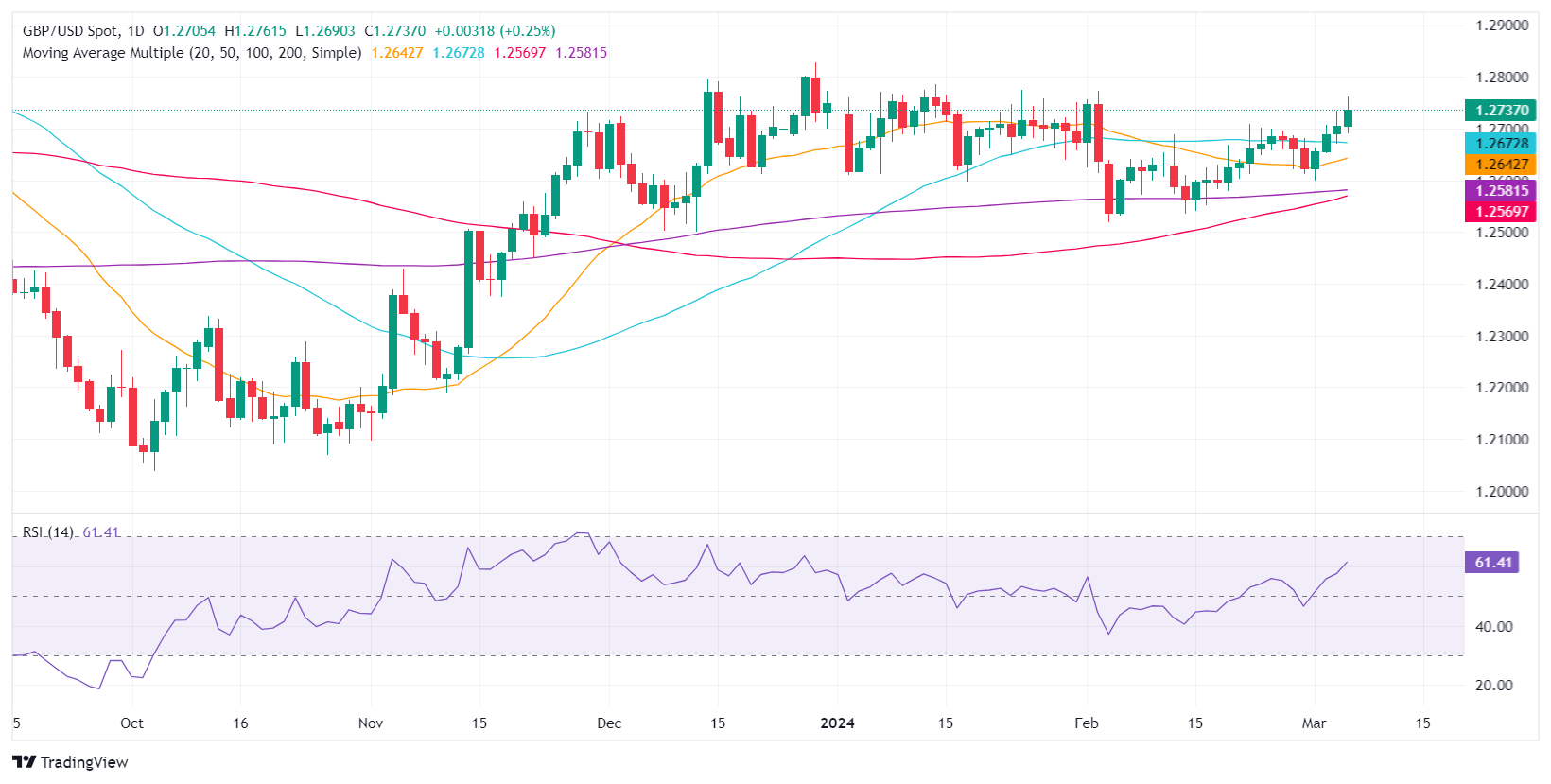
Pound Sterling FAQs
The Pound Sterling (GBP) is the oldest currency in the world (886 AD) and the official currency of the United Kingdom. It is the fourth most traded unit for foreign exchange (FX) in the world, accounting for 12% of all transactions, averaging $630 billion a day, according to 2022 data. Its key trading pairs are GBP/USD, aka ‘Cable’, which accounts for 11% of FX, GBP/JPY, or the ‘Dragon’ as it is known by traders (3%), and EUR/GBP (2%). The Pound Sterling is issued by the Bank of England (BoE).
The single most important factor influencing the value of the Pound Sterling is monetary policy decided by the Bank of England. The BoE bases its decisions on whether it has achieved its primary goal of “price stability” – a steady inflation rate of around 2%. Its primary tool for achieving this is the adjustment of interest rates. When inflation is too high, the BoE will try to rein it in by raising interest rates, making it more expensive for people and businesses to access credit. This is generally positive for GBP, as higher interest rates make the UK a more attractive place for global investors to park their money. When inflation falls too low it is a sign economic growth is slowing. In this scenario, the BoE will consider lowering interest rates to cheapen credit so businesses will borrow more to invest in growth-generating projects.
Data releases gauge the health of the economy and can impact the value of the Pound Sterling. Indicators such as GDP, Manufacturing and Services PMIs, and employment can all influence the direction of the GBP. A strong economy is good for Sterling. Not only does it attract more foreign investment but it may encourage the BoE to put up interest rates, which will directly strengthen GBP. Otherwise, if economic data is weak, the Pound Sterling is likely to fall.
Another significant data release for the Pound Sterling is the Trade Balance. This indicator measures the difference between what a country earns from its exports and what it spends on imports over a given period. If a country produces highly sought-after exports, its currency will benefit purely from the extra demand created from foreign buyers seeking to purchase these goods. Therefore, a positive net Trade Balance strengthens a currency and vice versa for a negative balance.
-
06.03.2024 09:41GBP/USD to press strong resistance at 1.2800/1.2825 – ING
Today sees UK Chancellor, Jeremy Hunt, present a pre-election budget. The Pound Sterling (GBP) is the only G10 currency to print positive total returns against the US Dollar (USD) this year. An expansionary UK budget would support the GBP, economists at ING say.
Chancellor Hunt to keep Sterling show on the road
Some decent fiscal stimulus should only delay the Bank of England easing cycle (we currently pencil in August for the first cut) and support Sterling.
There may also be focus on new measures to support the UK financial industry, such as a new Individual Savings Account with tax incentives to invest in British-listed securities. There has also been some petitioning of the Chancellor to lower or abolish the 0.5% stamp duty on UK share trading, which puts Britain at a disadvantage for listings relative to most competitors. Any move here, as long as it was funded, would prove a Sterling positive.
Overall, we are mildly positive on sterling today and can see a scenario where GBP/USD presses strong resistance at 1.2800/1.2825.
-
06.03.2024 05:46GBP/USD improves to near 1.2700 ahead of UK Budget Report
- GBP/USD recovers intraday losses ahead of the Budget Report from the United Kingdom on Wednesday.
- UK Chancellor Jeremy Hunt is expected to reduce national insurance contributions.
- Fed Chairman Jerome Powell will testify before the US Congress' House Financial Services Committee.
GBP/USD retraces daily losses and seems to continue its winning streak, hovering around 1.2700 during the Asian trading session before the UK Chancellor Jeremy Hunt's Budget Report on Wednesday. Hunt is slated to unveil the government's fiscal agenda, outlining tax and spending plans ahead of the general election. Speculation suggests he may reduce national insurance contributions for employees, following a 2p reduction announced in the autumn statement.
UK’s BRC Like-For-Like Retail Sales (YoY) for February fell short of expectations, posting a figure of 1.0% compared to the anticipated 1.6%. This figure contrasts with the previous period's 1.4%. Later in the day, the S&P Global/CIPS Construction PMI for February is scheduled to be released, offering further insights into the UK's economic performance.
The US Dollar Index (DXY) attempted to halt its three-day losing streak, but returned to near 103.80, driven by subdued US Treasury yields. The 2-year and 10-year yields on US Treasury bonds stand at 4.55% and 4.14%, respectively, by the press time.
Investors are closely watching Federal Reserve (Fed) Chairman Jerome Powell's testimony before the US Congress' House Financial Services Committee, scheduled for Wednesday and Thursday. However, the US Dollar (USD) encountered downward pressure following softer-than-expected data from the US ISM Services Purchasing Managers Index (PMI). Additionally, attention is on the ADP Employment Change report for February, set to be released in the North American session.
The ISM Services PMI fell to 52.6 in February, below the anticipated decrease to 53.0 from 53.4. Moreover, Factory Orders (MoM) declined by 3.6% in January, surpassing the expected drop of 2.9%. Former New York Fed economist Steven Friedman suggested that Federal Reserve policymakers are likely to remain cautious about interest rate cuts in 2024 due to growth and volatile inflation. He hinted at the possibility of fewer rate cuts than the three initially anticipated for 2024.
-
06.03.2024 00:28GBP/USD holds below the 1.2700 mark ahead of Fed's Powell testimony
- GBP/USD loses ground near 1.2695 amid renewed USD demand.
- The US Services PMI fell to 52.6 in February, worse than expected.
- Markets expect the Bank of England (BoE) to start cutting interest rates in August.
- Investors await the UK S&P Global Construction PMI and Fed Jerome Powell’s testimony on Wednesday.
The GBP/USD pair holds below the 1.2700 mark during the early Asian session on Wednesday. The downtick of the pair is backed by the renewed US Dollar (USD). Later on Wednesday, the UK S&P Global Construction PMI and the Federal Reserve’s (Fed) Jerome Powell’s testimony will be in the spotlight. GBP/USD currently trades near 1.2695, losing 0.08% on the day.
Atlanta Fed President Raphael Bostic said on Monday that he expects the first interest rate cut from the Fed, scheduled for the third quarter, will be followed by a pause in the subsequent meeting to evaluate the impact of the policy adjustment on the economy. According to the CME FedWatch Tool, financial markets have priced in 3.0% odds of a 25 basis point (bps) rate cut at the FOMC meeting in March.
The Institute for Supply Management (ISM) survey on Tuesday reported that US Services PMI slipped to 52.6 in February from 53.4 in January. The figures came in weaker than the expectation of 53.0.
On the other hand, the UK Chancellor Jeremy Hunt spoke at the Spring budget and cut national insurance by 2p in his budget on Wednesday. Apart from this, investors anticipate the Bank of England (BoE) to start cutting interest rates in August when inflation is expected to return to the 2% target before increasing again.
Later on Wednesday, Fed Chair Jerome Powell is set to speak before Congress for his semiannual testimony on Wednesday. The US Nonfarm Payrolls (NFP) on Friday will be the highlight for this week, which is forecast to add 200,000 jobs in February. Traders will take cues from the events and find trading opportunities around the GBP/USD pair. -
05.03.2024 17:52GBP/USD finds higher ground on Tuesday, steps over 1.2700
- GBP/USD climbs over 1.2700 on Tuesday.
- US PMI, Factory Orders misses push down Greenback.
- US politics to dominate headlines on Super Tuesday.
GBP/USD gained ground on Tuesday, marking in an intraday high of 1.2735 after the US ISM Services Purchasing Managers Index (PMI) and Factory Orders both missed expectations. The US Dollar (USD) softened on reaction, but market sentiment is hanging in the midrange as markets gear up for two showings from Federal Reserve (Fed) Chairman Jerome Powell this week.
US politics are also on the cards as Super Tuesday gets underway. The US Republican Party is broadly expected to select Donald Trump as the nominee for the party’s ballot in the upcoming US federal election in November.
The UK’s BRC Like-For-Like Retail Sales for the year ended February entirely missed expectations, printing at an even 1.0% early Tuesday, flubbing the forecast increase 1.6% from the previous period’s 1.4%. The US ISM Services PMI for February fell more than expected, printing at 52.6 versus the forecast 53.0 and the previous 53.4.
Fed chair Powell will be appearing twice this week, on both Wednesday and Thursday as the head of the US central bank testifies about the Fed’s Semi-Annual Monetary Policy Report to the US government’s House Financial Services Committee. Headlines are expected throughout both days as the Fed chairman answers policymaker questions about the US economy and the Fed’s outlook.
US labor figures are also due to make a splash this week. ADP Employment Change figures are due Wednesday and forecast to increase to 150K from the previous 107K, and Friday’s US Nonfarm Payrolls (NFP) is expected to decline to 200K from the previous 353K, and revisions to previous prints are expected.
GBPUSD tests higher, but topside limited near 1.2700
GBP/USD rose through Tuesday’s trading, testing north of 1.2700 but mixed market sentiment is keeping the pair close to key levels as momentum remains limited. The pair broke through a key resistance layer, and a pullback could see bullish momentum extend as long as declines remain limited to the 1.2700 region.
Plenty of longer-term technical resistance is baked into daily candlesticks. 1.2800 remains a key level for bulls to beat, and the 200-day Simple Moving Average (SMA) continues to grind slowly higher, reaching 1.2580.
GBP/USD hourly chart

GBP/USD daily chart

-
05.03.2024 12:45GBP/USD will have to overcome 1.2700/1.2710 for gains to extend – Scotiabank
GBP/USD is marginally lower on the day but is essentially marking time in its established trading range of 1.2520/1.2825. Economists at Scotiabank analyze the pair’s outlook.
Trend dynamics and price signals are bullish on the intraday chart
Sterling is a little above the midpoint of the broad, 1.2520/1.2825 range in pace since the start of the year.
Trend dynamics and price signals are bullish on the intraday chart but the daily chart reflects resistance at 1.2700/1.2710 which the GBP will have to overcome for gains to extend.
Support is 1.2600.
© 2000-2024. All rights reserved.
This site is managed by Teletrade D.J. LLC 2351 LLC 2022 (Euro House, Richmond Hill Road, Kingstown, VC0100, St. Vincent and the Grenadines).
The information on this website is for informational purposes only and does not constitute any investment advice.
The company does not serve or provide services to customers who are residents of the US, Canada, Iran, The Democratic People's Republic of Korea, Yemen and FATF blacklisted countries.
Making transactions on financial markets with marginal financial instruments opens up wide possibilities and allows investors who are willing to take risks to earn high profits, carrying a potentially high risk of losses at the same time. Therefore you should responsibly approach the issue of choosing the appropriate investment strategy, taking the available resources into account, before starting trading.
Use of the information: full or partial use of materials from this website must always be referenced to TeleTrade as the source of information. Use of the materials on the Internet must be accompanied by a hyperlink to teletrade.org. Automatic import of materials and information from this website is prohibited.
Please contact our PR department if you have any questions or need assistance at pr@teletrade.global.















